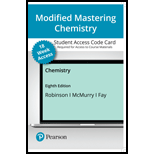
Concept explainers
(a)
Interpretation:
The charge clouds around the central atom in a molecule that has seesaw geometry should be predicted.
Concept introduction:
The molecular structure is a 3-dimensional representation of bond pairs around the central atom. It is also known as molecular geometry. Electron geometry is a 3-dimensional representation of bond pairs and lone pairs around the central atom. Shape corresponds to electron geometry and geometry corresponds to molecular geometry or structure.
(b)
Interpretation:
The charge clouds around the central atom in a molecule that has square planar geometry should be predicted.
Concept introduction:
The molecular structure is a 3-dimensional representation of bond pairs around the central atom. It is also known as molecular geometry. Electron geometry is a 3-dimensional representation of bond pairs and lone pairs around the central atom. Shape corresponds to electron geometry and geometry corresponds to molecular geometry or structure.
(c)
Interpretation:
The charge clouds around the central atom in a molecule that has trigonal bipyramidal geometry should be predicted.
Concept introduction:
The molecular structure is a 3-dimensional representation of bond pairs around the central atom. It is also known as molecular geometry. Electron geometry is a 3-dimensional representation of bond pairs and lone pairs around the central atom. Shape corresponds to electron geometry and geometry corresponds to molecular geometry or structure.
(d)
Interpretation:
The charge clouds around the central atom in a molecule that has T-shaped geometry should be predicted.
Concept introduction:
The molecular structure is a 3-dimensional representation of bond pairs around the central atom. It is also known as molecular geometry. Electron geometry is a 3-dimensional representation of bond pairs and lone pairs around the central atom. Shape corresponds to electron geometry and geometry corresponds to molecular geometry or structure.
(e)
Interpretation:
The charge clouds around the central atom in a molecule that has trigonal planar geometry should be predicted.
Concept introduction:
The molecular structure is a 3-dimensional representation of bond pairs around the central atom. It is also known as molecular geometry. Electron geometry is a 3-dimensional representation of bond pairs and lone pairs around the central atom. Shape corresponds to electron geometry and geometry corresponds to molecular geometry or structure.
(f)
Interpretation:
The charge clouds around the central atom in a molecule that has linear geometry should be predicted.
Concept introduction:
The molecular structure is a 3-dimensional representation of bond pairs around the central atom. It is also known as molecular geometry. Electron geometry is a 3-dimensional representation of bond pairs and lone pairs around the central atom. Shape corresponds to electron geometry and geometry corresponds to molecular geometry or structure.
Want to see the full answer?
Check out a sample textbook solution
Chapter 8 Solutions
CHEMISTRY-MOD.MASTERING (18W)
- What is the product of the reaction? F3C. CF3 OMe NaOH / H₂Oarrow_forwardWhat would you expect to be the major product obtained from the following reaction? Please explain what is happening here. Provide a detailed explanation and a drawing showing how the reaction occurs. The correct answer to this question is V.arrow_forwardPlease answer the question for the reactions, thank youarrow_forward
- What is the product of the following reaction? Please include a detailed explanation of what is happening in this question. Include a drawing showing how the reagent is reacting with the catalyst to produce the correct product. The correct answer is IV.arrow_forwardPlease complete the reactions, thank youarrow_forwardConsider the synthesis. What is compound Y? Please explain what is happening in this question. Provide a detailed explanation and a drawing to show how the compound Y creates the product. The correct answer is D.arrow_forward
- What would be the major product of the following reaction? Please include a detailed explanation of what is happening in this question. Include steps and a drawing to show this reaction proceeds and how the final product is formed. The correct answer is B. I put answer D and I don't really understand what is going on in the question.arrow_forwardWhat is the product of the following reaction? Please explain what is happening in this question. Provide a detailed explanation and a drawing showing how the reagent is reacting with the catalysts to product the correct product. The correct answer is B.arrow_forwardWhat is the missing intermediate 1 and the final product 2. Please include a detailed explanation explaining the steps of malonic ester synthesis. Please include drawings of the intermediate and how it occurs and how the final product is former.arrow_forward
 Chemistry: Principles and PracticeChemistryISBN:9780534420123Author:Daniel L. Reger, Scott R. Goode, David W. Ball, Edward MercerPublisher:Cengage Learning
Chemistry: Principles and PracticeChemistryISBN:9780534420123Author:Daniel L. Reger, Scott R. Goode, David W. Ball, Edward MercerPublisher:Cengage Learning Chemistry & Chemical ReactivityChemistryISBN:9781337399074Author:John C. Kotz, Paul M. Treichel, John Townsend, David TreichelPublisher:Cengage Learning
Chemistry & Chemical ReactivityChemistryISBN:9781337399074Author:John C. Kotz, Paul M. Treichel, John Townsend, David TreichelPublisher:Cengage Learning Introductory Chemistry: An Active Learning Approa...ChemistryISBN:9781305079250Author:Mark S. Cracolice, Ed PetersPublisher:Cengage Learning
Introductory Chemistry: An Active Learning Approa...ChemistryISBN:9781305079250Author:Mark S. Cracolice, Ed PetersPublisher:Cengage Learning Chemistry & Chemical ReactivityChemistryISBN:9781133949640Author:John C. Kotz, Paul M. Treichel, John Townsend, David TreichelPublisher:Cengage Learning
Chemistry & Chemical ReactivityChemistryISBN:9781133949640Author:John C. Kotz, Paul M. Treichel, John Townsend, David TreichelPublisher:Cengage Learning Chemistry: The Molecular ScienceChemistryISBN:9781285199047Author:John W. Moore, Conrad L. StanitskiPublisher:Cengage Learning
Chemistry: The Molecular ScienceChemistryISBN:9781285199047Author:John W. Moore, Conrad L. StanitskiPublisher:Cengage Learning World of Chemistry, 3rd editionChemistryISBN:9781133109655Author:Steven S. Zumdahl, Susan L. Zumdahl, Donald J. DeCostePublisher:Brooks / Cole / Cengage Learning
World of Chemistry, 3rd editionChemistryISBN:9781133109655Author:Steven S. Zumdahl, Susan L. Zumdahl, Donald J. DeCostePublisher:Brooks / Cole / Cengage Learning





